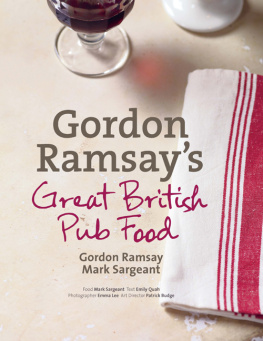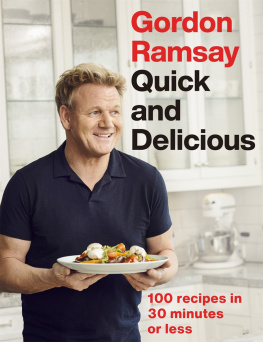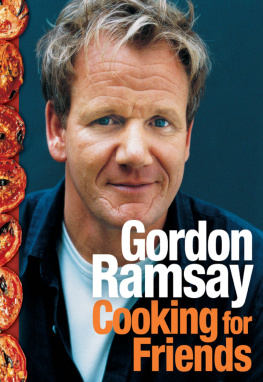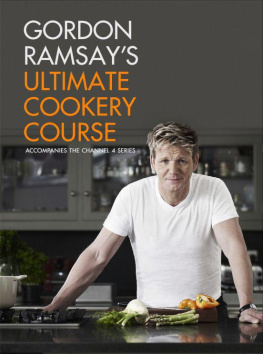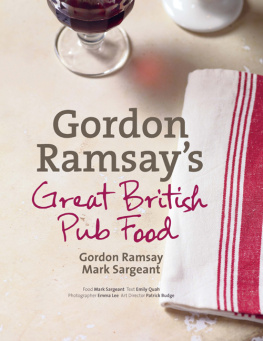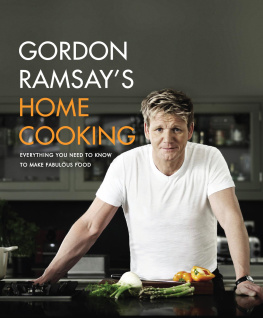Gordon Ramsay - Gordon Ramsay’s Great British Pub Food
Here you can read online Gordon Ramsay - Gordon Ramsay’s Great British Pub Food full text of the book (entire story) in english for free. Download pdf and epub, get meaning, cover and reviews about this ebook. year: 2010, publisher: HarperCollins UK, genre: Home and family. Description of the work, (preface) as well as reviews are available. Best literature library LitArk.com created for fans of good reading and offers a wide selection of genres:
Romance novel
Science fiction
Adventure
Detective
Science
History
Home and family
Prose
Art
Politics
Computer
Non-fiction
Religion
Business
Children
Humor
Choose a favorite category and find really read worthwhile books. Enjoy immersion in the world of imagination, feel the emotions of the characters or learn something new for yourself, make an fascinating discovery.
- Book:Gordon Ramsay’s Great British Pub Food
- Author:
- Publisher:HarperCollins UK
- Genre:
- Year:2010
- Rating:4 / 5
- Favourites:Add to favourites
- Your mark:
- 80
- 1
- 2
- 3
- 4
- 5
Gordon Ramsay’s Great British Pub Food: summary, description and annotation
We offer to read an annotation, description, summary or preface (depends on what the author of the book "Gordon Ramsay’s Great British Pub Food" wrote himself). If you haven't found the necessary information about the book — write in the comments, we will try to find it.
Gordon Ramsay’s Great British Pub Food — read online for free the complete book (whole text) full work
Below is the text of the book, divided by pages. System saving the place of the last page read, allows you to conveniently read the book "Gordon Ramsay’s Great British Pub Food" online for free, without having to search again every time where you left off. Put a bookmark, and you can go to the page where you finished reading at any time.
Font size:
Interval:
Bookmark:
Spoon measures are level, unless otherwise specified:
1 tsp is equivalent to 5ml; 1 tbsp is equivalent to 15ml.
Use good-quality sea salt, freshly ground pepper and fresh herbs for the best flavour.
Use large eggs unless otherwise suggested, ideally organic or free-range. If you are pregnant or in a vulnerable health group, avoid dishes using raw egg whites or lightly cooked eggs.
Oven timings are for fan-assisted ovens. If using a conventional oven, increase the temperature by 15C (1 Gas Mark). Individual ovens may vary in actual temperature by 10 from the setting, so it is important to know your oven. Use an oven thermometer to check its accuracy.
Timings are provided as guidelines, with a description of colour or texture where appropriate, but readers should rely on their own judgement as to when a dish is properly cooked.
The great British Pub has played an important and unique role in British society right from Roman times, through the Middle Ages and up to the present day. It is a role that has changed, adapted and evolved as society has dictated, but the pub has always maintained its focus as the place to go to relax, to celebrate, to mourn, to talk, to drink and, increasingly, to eat.
As a social chronicle, the pub has documented every cultural trend, often hand in hand with a legislative force that appears intent on protecting society. From controlling the hours during which pubs were allowed to open, to the most recent change, the banning of smoking, laws have tested the ingenuity of publicans to keep their doors open for business.
It might seem surprising that eating wasnt traditionally part of pub life. The earliest taverns may have supplied bread with the ale, but the concept of eating out had not been born. You ate at home and you went to the pub for your social needs. This was where you drank, smoked and sought entertainment through conversation. It catered for the social divide with public rooms and screened-off snugs where employers, the employed, the vicar, the widower and the retired could go, albeit often with a pricing hierarchy. A pint in the discrete snug with its frosted glass and privacy simply cost more.
The advent of television beckoned the end of the pub as the social epicentre. The concept of buying alcohol and taking it home was not lost on the evolving supermarket owners, who responded by stacking their shelves accordingly. Home now offered comfort with entertainment and without the restrictions of closing time or the risk of a drink-drive prosecution. The publican had to think hard in order to survive. Trade fell off. Real ale wasnt consumed at the same rate and suddenly the contents of barrels reached their best by date before they had run dry. The brewers countered with a longer life offer, lager, which lived under pressure but it did not take away the problem of a diminished flow of alcohol.
Often the management, tenancy or ownership of a pub lay with a married couple. It was an ideal partnership in this social centre where the husband could attend to the barrel changing and control of his customers, while the wife busied herself with glass-washing and looking after the premises. If the business of serving beer was no longer what kept the bar team running around with the till ringing in the background, there had to be an opportunity for another offering.
There was now time and space for food. The concept of eating out was still in its infancy and the one overriding restriction was cost. The publican already had the premises, the seating and staff. All he had to do was arrange for a kitchen and a simple, good value bar menu to be made available. It was not only an opportunity to increase the flow of cash across the bar, but would, in time, bring back some of that lost wet trade. Moreover, a pub that began to make a name for itself for the quality of its food flourished. A restaurant was expensive and often made its new public feel uncomfortable. The pub had found a niche and suddenly there was the possibility for almost fifty thousand outlets to refocus their business.
The ban on smoking did pubs with grub no damage. On the contrary, it took away the one spoiler to eating good food in a convivial atmosphere. And there can be little doubt that any trade lost due to smokers who remained in their homes was regained as others now ventured forth to sample the food offerings of their local.
When we opened the Gordon Ramsay pubs in London, we wanted to give the public fantastic but casual food, served up alongside a few good pints and at a price that wouldnt break the bank. Not posh nosh, but classic British dishes that have stood the test of time. Our mantra has always been keep it simple and make it tasty and thats exactly what we wanted to deliver in the pubs. We also wanted to bring back a few old-fashioned favourites, like cottage pie with Guinness, Lancashire hotpot and irresistibly sticky treacle tart.
This book brings to you dishes that have become pub classics. It offers simple, reasonably priced recipes that you can cook at home without fuss or complication. This is the food that has brought the British pub on to the culinary map.
Pint of prawns with mayo
Oysters with shallot vinegar
Devilled whitebait
Scotch eggs
Spiced nuts
Homemade pork scratchings
Angels and devils on horseback
Pan haggerty
Old-fashioned pork pies
Homemade crisps
Pickled quails eggs
Wild boar sausage rolls
1-1.2kg cooked Atlantic prawns in shells
2 large egg yolks
1 tsp white wine vinegar
1 tsp English mustard
sea salt and black pepper
300ml groundnut oil (or light olive oil)
1 tbsp water
Walk into any pub and you are quite likely to find a pint of prawns with mayo on the bar menu. These tasty morsels from the Atlantic are perfect finger food to savour with a pint of light ale or a glass of dry white wine. As you peel off the shells from the prawns, suck the heads so you dont miss out on their amazing flavour.
To make the mayonnaise, put the egg yolks, wine vinegar, mustard and some salt and pepper into a blender or small food processor and whiz until the mixture is very thick and creamy. With the motor running, slowly trickle in the oil through the funnel in a steady stream. Add 1 tbsp water to help stabilize the emulsion, then taste and adjust the seasoning. (If the mayonnaise splits, transfer it to a bowl and start again. Whiz another egg yolk in the blender or processor until thick and then slowly blend in the split mixture; it should re-emulsify.)
Spoon the mayonnaise into individual dipping bowls and divide the prawns between four pint glasses. You might also want to put out an empty bowl for the shells. Any extra mayonnaise can be kept in a covered bowl in the fridge for up to 3 days.
2 shallots, peeled and finely chopped
120ml good-quality red wine vinegar (we use Cabernet Sauvignon)
12-16 very fresh native oysters
rock salt
fresh seaweed (optional), to garnish
Sharing a platter of fresh oysters at the bar is a real treat. In London, our native oysters usually hail from Colchester or Whitstable, but they are gathered in various places around the British coast. Freshness is absolutely vital, so it helps to know your nearest source. Spanking fresh oysters taste of the sea.
Mix the shallots and wine vinegar together in a small bowl and leave to infuse for at least an hour. Spread a thick layer of rock salt on one or two serving platters and scatter over the seaweed, if available.
Font size:
Interval:
Bookmark:
Similar books «Gordon Ramsay’s Great British Pub Food»
Look at similar books to Gordon Ramsay’s Great British Pub Food. We have selected literature similar in name and meaning in the hope of providing readers with more options to find new, interesting, not yet read works.
Discussion, reviews of the book Gordon Ramsay’s Great British Pub Food and just readers' own opinions. Leave your comments, write what you think about the work, its meaning or the main characters. Specify what exactly you liked and what you didn't like, and why you think so.

